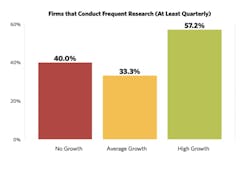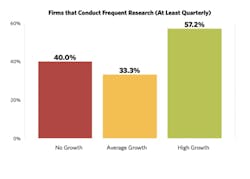A time for fearlessness: Lessons from high growth AEC firms
Nothing motivates change more than a crisis. Many professional services firms have made more radical shifts in how they do business over the past two months than over the past decade. But for AEC firms across many states, their “essential status” has sheltered them from the effects of shut-down orders. Moreover, the nature of field work that lies at the heart of the industry had propelled most, if not all, AEC firms’ embrace of mobile devices far earlier than other segments of professional services firms. The shift to working from home has been less painful, less disruptive, and more “business as usual”.
Yet when uncertainty reaches new heights, a penchant for objective understanding supported by relevant data is indispensable. And, as Hinge’s 2020 High Growth Study: Architecture, Engineering, & Construction Edition shows, it positions companies for success. Hinge defines High Growth firms as those that posted 20% or more annual growth over each of the last three years. These firms emerge in sharp relief for growing three times faster than their average-growth peers and for being more than twice as likely to be more profitable (gross profit figures exceeding 11%). What explains these stellar performers’ extraordinary growth and profitability? What are High Growth firms doing differently? Surprisingly, it’s not just M&A—it’s also marketing.
Crossing the digital divide
As it turns out, one of the High Grown firms’ superpower is digital marketing. Shifting marketing and business development processes online has enabled these firms to generate new business through digital channels because they’ve invested in foundational infrastructure. The pivot to digital marketing is nothing new. For years, studies like Hinge Research Institute’s annual High Growth Study have shown a yawning gap between early adopters of digital marketing and those that opted to wait. The 2020 study is no exception, showing High Growth AEC firms expended 25% more effort across a broad range of digital marketing techniques, while their No Growth peers focused on ads. The former also invested twice as much effort into video, audio, SEO, and thought leadership content distribution via social media.
Customer reach and intimacy
Digital techniques offered High Growth firms two distinct advantages. First, firms could better understand their buyers across the customer journey, which often starts with an online search. Almost 70 percent of buyers say they use digital channels to research their business problems. Second, firms could better serve prospects and customers at every phase of that journey, which only two months ago shifted dramatically online due to the COVID-19 pandemic. Understanding their target audiences lies at the heart of High Growth firms’ strategies. The study shows that they were 56% more likely to conduct frequent research.
By combining frequent market research with digital marketing, High-Growth AEC firms have realized 50% more marketing impact across nearly all digital and content marketing activities. The only advantage No Growth firms had was in digital ads, yet the meager results failed to justify the level of effort. The better they know the audiences they serve, the more effective High Growth firms become at conveying the right messages and, as a result, persuading their audiences.
Shrinking the perception gap
At least 60% of all AEC firms in the study cited brand differentiation and content creation as their top two marketing priorities. In fact, over one-third of firms’ top marketing priorities were linked to offering educational thought leadership. Frequent research and outreach efforts through digital channels is helping High Growth firms close the gap between brand identity—how a firm sees itself--and brand image—how audiences see the firm. High Growth firms are able to demonstrate the unique value they offer as experts not only through thought leadership articles but also through case stories, a proven method of demonstrating relevant past performance. In fact, High Growth firms were nearly three times likely to develop case stories that convince their audiences of their expertise and track record of success.
Fearless ideas in uncertain times
With the pandemic well underway and likely to shape professional services buying behavior for years to come, AEC firms must take bold steps to stay relevant in a rapidly shifting business environment. If they want to break through the noise, they must be able to tell their story in a way that flexes their expertise in solving their target audiences’ problems, as well as in sharing those stories through the most accessible channels—digital.
Waiting things out is no longer an option. Firms must move beyond their comfort zone and adopt the behaviors of their fast-growing, more agile peers. If they don’t reinvent themselves today, tomorrow may be too late.
About the Author:
Karl Feldman is a seasoned entrepreneur with executive roots who leads Hinge’s client service delivery. A former engineer, Karl founded several VC backed ventures before moving into the professional services industry. Before joining Hinge, Karl directed marketing for a top-50 construction firm.


